There’s a renewed interest in antique Tea Carts amongst homeowners. They add an elegant touch to your home. The evolution from pure functionality to decorative purposes is interesting.
Should we thank the Emmy award-winning TV series Mad Men or Netflix’s Bridgerton for increasing sales of 19th-century items?
Whichever it is, increased demand with limited supply leaves room for fakes. If you’re not careful, you may spend so much on a worthless item. This guide helps you identify and value an antique tea cart like a pro.
Table of Contents
The Evolution of the English Tea Cart
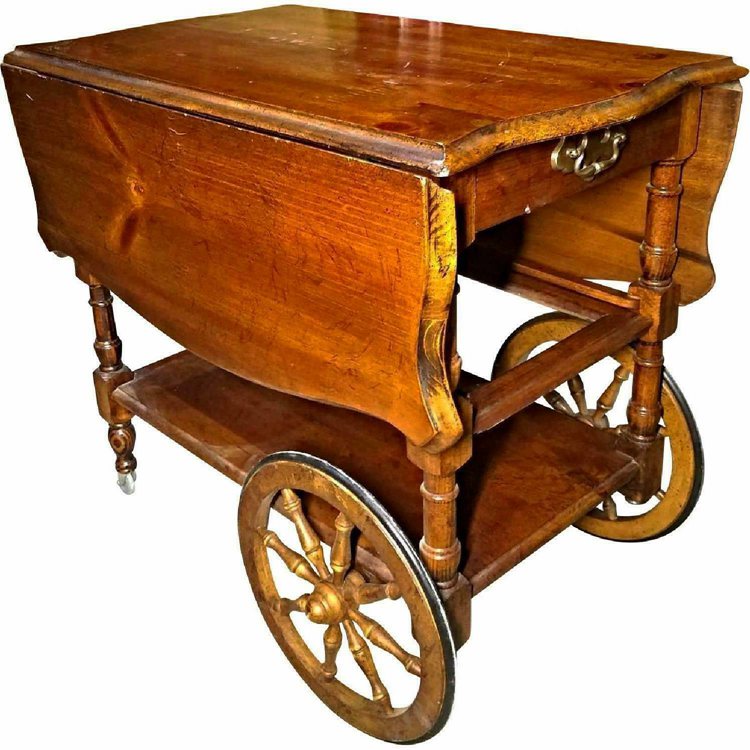
How did this simple furniture become a status symbol? Let’s take it back to the beginning.
Our story starts in the 1600s in England. The Tea Cart had its ups and down through centuries. It’s gone from an elite accessory to an almost relic and finally settling as a household staple.
Butlers in upper-class homes used tables with four wheels – two big ones in front and two small ones at the back – for easy service during afternoon tea time.
These tables had double layers, so exotic brews and food stayed lower while dishware sat at the top. This invention saved servers from extra trips to and from the kitchen.
Our little friend didn’t become notorious until the 1800s. With more women hosting tea parties in the Victorian Era, the Tea Cart gained notoriety. You could serve a variety of snacks and tea on this moving table with ease.
During the Prohibition Era, when importation and sale of alcohol were illegal, people got creative! They hosted speakeasies where they shared alcohol around in TEA CARTS. By 1920, the Tea Cart wheeled its way into America.
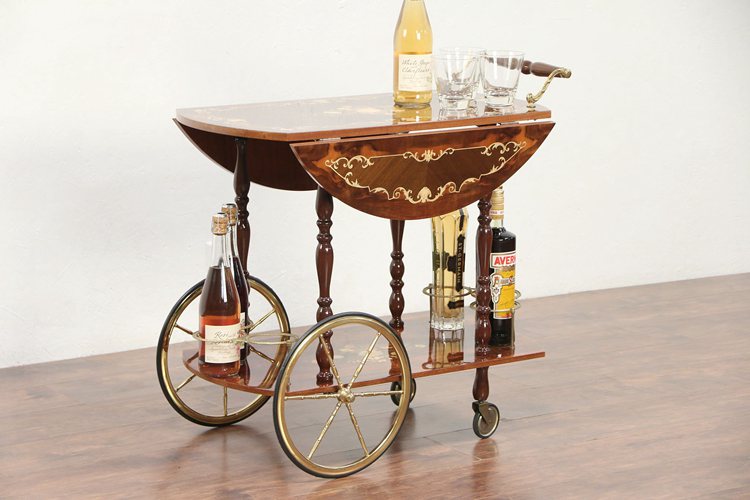
And like a scene right out of The Great Gatsby movie! Who needs tea when you can have brandy in a teacup? The Tea Cart became the “Bar Cart.”
Eventually, the Prohibition era ended, but the second world war began. As families got poor, partying became the least of their worries. Enter the Great Depression, exit the bar cart.
Our story doesn’t end there, though. After the war, there was a sudden prosperity boom – hello party people, welcome back the bar cart. In the 1950s, the table on wheels became popular amongst Hollywood celebrities.
Everyone wanted to have a tea cart at home. It became a luxury symbol. The tea cart is so reminiscent of the era that you can’t watch a classic without it featuring.
As they say, “all good things must end someday.” With more people hosting house parties, the need for a bigger drink wagon arose. So, the 1970s introduced the in-house bar, which seemingly ended the bar cart’s run.
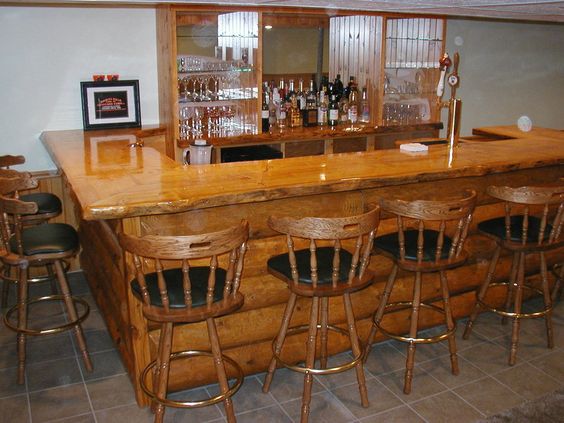
How To Identify an Antique Tea Cart?
Modern media has a way of influencing people. So, we wouldn’t be surprised when people who had no former interest in antiques suddenly began to want one in their space after seeing scenes from movies like the Mad Men.
One thing about antiques is the limited supply. So, there’s a chance for dodgy dealers trying to create fake tea carts and present them as the real thing. In this section of this article, allow us to be your guide and show you how to identify an original antique from a forgery.
By the time you finish reading this, you’ll be able to appraise antiques like a professional. Let’s get to it.
Sign One: The Wood Material
Furniture materials are a major tell-tale of its production era. For instance, no one used Plywood until 1930. The Victorian era used Walnut, Mahogany, and Oak.
Antique Tea Carts are made of wood, specifically, Mahogany and Walnut. So, if your item has a modern raw material, it’s likely a reproduction.
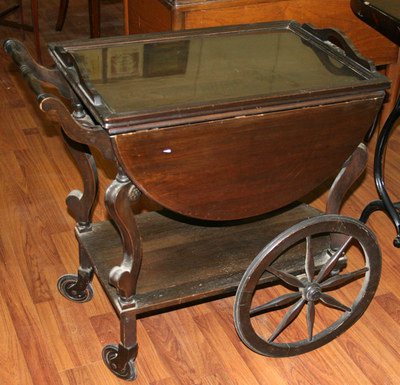
Still, on the wood material, you should also proceed to check the tea cart finishing. Antiques have a rough texture because of the sandpaper used to shave them clean. Only machines can give a smooth surface so, beware.
Also, mixed-wood is good. Those wood qualities were expensive, so they used cheap materials for unseen parts. 17th-century carpenters couldn’t use one material all through.
On that note, if your tea cart is made of only one type of wood material, this calls for suspicion.
Sign Two: The Bolts and Nut Material
Victorian furniture used shallow spiral or square screws. Before 1880, screws had little to no taper. Round nails didn’t exist until the 1900s. So, take a good look at the bolts in your tea cart’s wheels.
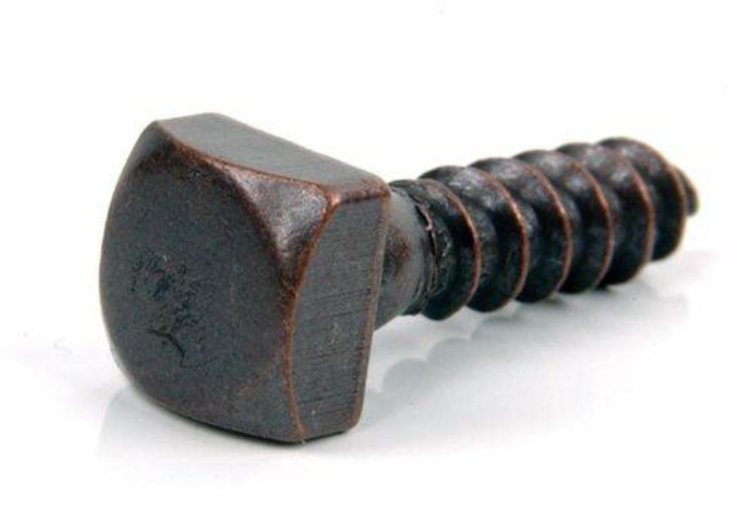
Sign Three: Aging, Wear and Tear
The same way human features change as we age, wood does too. Before you go on, please note that “Antique” is different from “Vintage.” While the former is at least a hundred years old, the latter is less than that but older than fifty.
Run your fingers along your tea cart’s surface to check for fingerprints. After several years of passing this antique from one hand to another, it is possible to leave a trail. You may see chips or cracks in some parts of the item.
Also, you’ll notice slight markings on your antique tea cart. A scratch here, and discoloration there. It’s typical of antique wooden furniture.
Sign Four: Shrinkage
Wood shrinks with time as a reaction to the weather. It’s not uncommon for antique tea carts to distort. Your alarm bells should ring if your item has a perfect shape as if produced yesterday.
Now you can tell a vintage tea cart from an antique.
Sign Five: Style
Antique tea carts are chunky and thick. The top often has two flaps on the side that can move up and down. They move on two giant wheels in front and two small ones on the rear.
The bar chart of the Prohibition era is sleek. It has no drop leaves, only a single tabletop. The four wheels are small, unlike the 17th-century carts with irregular-sized wheels.
This is how you will know the difference between Victorian-style tea carts and American bar carts. The modern imitations take after the sleek American style. They come in different shapes, and materials including – steel, plastic, and wrought iron.
How To Value an Antique Tea Cart?
Now that you can identify an antique tea cart, the next thing is the appraisal. All relics don’t cost the same amount. The price ranges from $30-$1500 or more.
You should also know that several factors add to or remove from the value of an item.
Why do you need to know this? We don’t know which is worse – overpaying or undervaluing your antique tea cart. It would be best if you covered your bases, so you don’t lose either way. Let’s dive straight into these factors;
Availability
If there are multiple similar designs to your tea cart, the value would be less. The whole point of possessing an antique is exclusivity. Why should you pay more for a common item?
So, if you see the exact style of your tea cart somewhere else, there’s a high chance it’s factory-made. This doesn’t mean it’s not an antique.
Finishing
Some people refinish their antique tea carts in a bid to make them neat. Doing that would be counterproductive. For every time you restore an antique, the value drops.
Please don’t alter your antique tea cart. You can clean it with basic agents but don’t repaint or change the features. High-value antique items are the untampered ones.
In the same vein, don’t buy a fixed relic for the price of an untouched one.
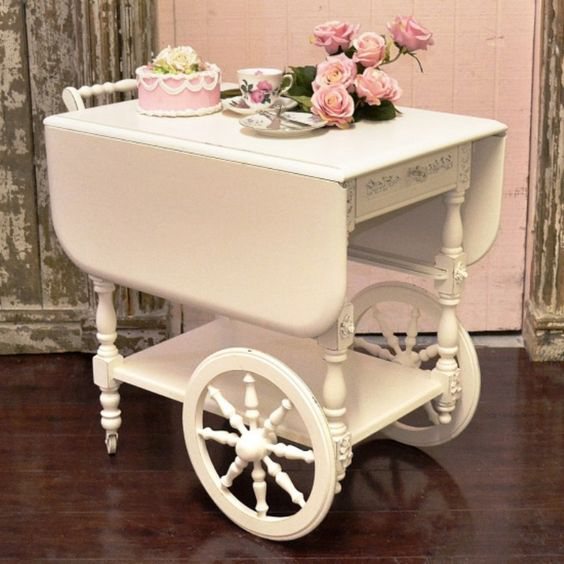
Design
Antique tea carts are handcrafted with no single machine fixture. That’s one of the restoration risks – you either fix the damage Victorian style or leave it. Once you use a machine to screw in a bolt or trim a bump, your item depreciates.
People appreciate antiques for their rustic style. There’s a certain je ne sais quoi about original handcrafted furniture.
Also, notable brands may cost more than unknown names. For instance, this antique oak tea cart is $825 on eBay. That’s one of the expensive bids you can get.
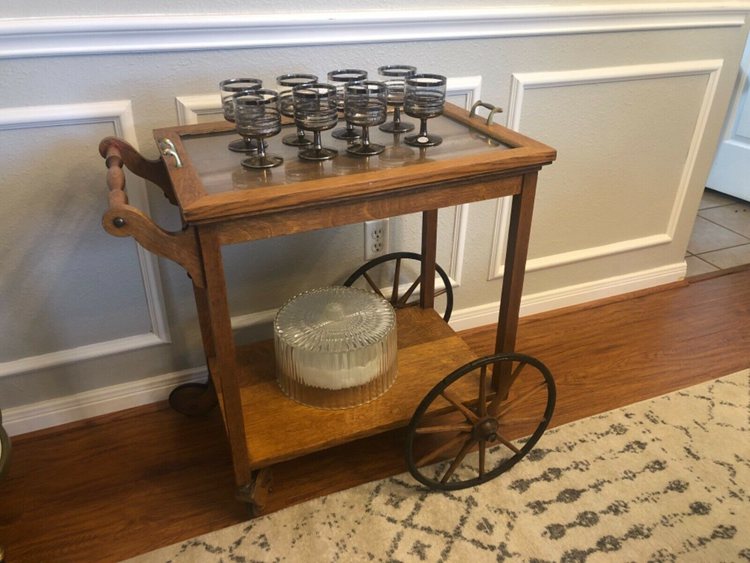
Research
You can’t find every piece of information on each item because of its rarity. What you can do instead is research on the Victorian era. Read books, watch documentaries, attend forums online.
Remember, each material is a time-stamp so, the more you know about the era, the more you’ll learn about their furniture.
Some popular online stores that sell antiques are eBay and Etsy. You can also attend auctions, but there’s no guarantee of the product’s originality.
Final Thoughts
We’ve enjoyed taking this trip down memory lane with you. Please note that we don’t intend to disregard the modern imitation of the antique tea cart. We appreciate the effort to preserve history by reimagining this staple item.
The essence of this guide is to keep you from wasting money on worthless pieces. Also, to help you gain money on priceless ones. Here’s a quick list to help you remember;
- Note the material and aging
- Restored items aren’t antiques anymore
- There’s nothing like too much knowledge on antiques
Please leave a comment – we’d love to hear from you.






![Vintage Schwinn Bikes: [Types, Identification, and Values]](https://www.txantiquemall.com/wp-content/uploads/2022/05/5.-Schwinn-1967-Ramshorn-Fastback-Stingray-Sky-Blue-vtg-600x450.jpg)
